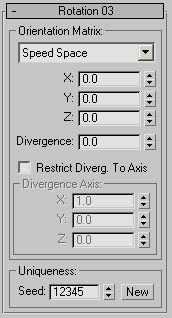The Rotation operator lets you set and animate particle orientation during an event, with optional random variation. You can apply orientation in any of five different matrices: two random and three explicit. For some options you can set a degree of random variation or divergence from the specified orientation.
To cause particles to spin, use the Spin operator.
Interface

The user interface appears in the parameters panel, on the right side of the Particle View dialog.
Orientation Matrix group
- Orientation drop-down list
- The Orientation Matrix drop-down list includes options that give particles random orientations, or let you specify orientation in any of three different ways. Default=Random 3D.
- Random 3D Gives each particle an arbitrary, random 3D orientation.
- Random Horizontal Gives each particle an arbitrary, random 3D orientation about the Z axis only. Rotation about the X and Y axes doesn't change (unless Divergence is used), so the particles remain vertical.
- World Space Orientation is specified in the world coordinate space.
Use the X/Y/Z settings to specify the orientation for all particles.
- Speed Space The coordinate space for particle orientation is determined by the particles' direction upon entering the event.
By default, using the Speed operator
 Along Icon Arrow option, particles are aimed straight down when born.
Along Icon Arrow option, particles are aimed straight down when born. Use the X/Y/Z settings to specify the orientation for all particles.
- Speed Space Follow The coordinate space for particle orientation is determined continually while the particles are in the event. Thus, by default, particles constantly reorient themselves to “aim” in the direction they're traveling.
For example, if you add a Find Target test to the end of the default Event 01, move the target sideways, and set Rotation to Speed Space Follow, the particles start out pointing straight down, as oriented by the Speed operator, and then gradually reorient themselves to point in the direction they're traveling: toward the target.
Use the X/Y/Z settings to specify the orientation for all particles. The Divergence setting is unavailable when using Speed Space Follow.
- X/Y/Z
- Set the basic orientation about the particles' local axes. Unavailable with the Random 3D and Random Horizontal options.
- Divergence
- Defines the range of variation (in degrees) for particle orientation. The actual deviation is calculated at random within this range. Unavailable with the Random 3D or Speed Space Follow option. Default=0.0.
- Restrict Diverg[ence] To Axis
- When on, lets you use the Divergence Axis controls to set the axis to which divergence will be applied. When off, Particle Flow uses a random axis for each particle. Unavailable with the Random 3D or Speed Space Follow option. Default=off.
- Divergence Axis
- Use the X/Y/Z settings to set the axis to which divergence will be applied. Default=1,0,0. Range=–1.0 to 1.0.
To specify one of the world axes, set the corresponding parameter to any nonzero value, and the others to 0. A negative value flips the axis. The numeric values come into play when you want to use an axis that's not aligned with the X, Y, or Z axis. In that case, you specify multiple nonzero values whose effect is relative to one another. For example, if you want the axis to be oriented halfway between the positive X and Y axes, you would set X and Y to the same positive amount. The actual value doesn't matter. Similarly, to set the axis to 30 degrees (1/3 of the angle) from the X axis to the Y axis, you'd set the Y value to twice that of the X value. For example, X=0.2 and Y=0.4, or X=0.5 and Y=1.0.
Uniqueness group
The Uniqueness setting affects the randomization of orientation with the Random 3D and Random Horizontal options, and also Divergence.
- Seed
- Specifies a randomization value.
- New
- Calculates a new seed using a randomization formula.